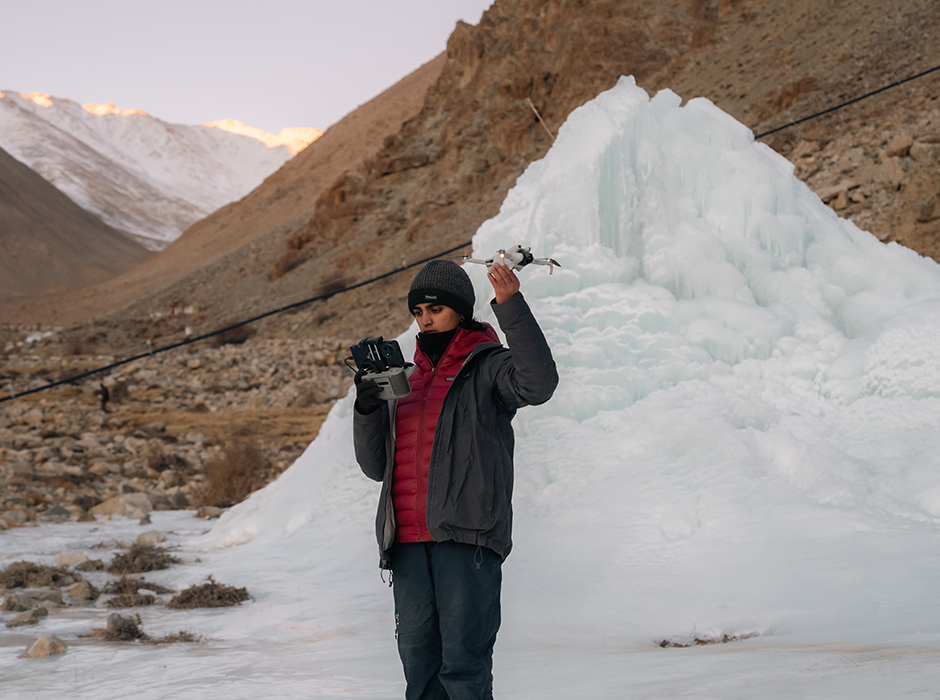
Karuna Sah’s Postgraduate Diploma in Science Communication included an internship in India’s Ladakh region for a startup company working on nature-based climate adaptation.
Raised in the Himalayas, Karuna Sah’s path into earth science was shaped by the surrounding mountains that defined her daily life.
Karuna’s first experience with the University of Otago was on a study abroad programme while completing her studies in the United States. Her semester spent at Otago cemented her desire to specialise in glaciology.
In 2024, Karuna completed Otago’s Postgraduate Diploma in Science Communication by distance. Her studies included an internship for a startup company working on nature-based climate adaptation in India’s Ladakh region.
Guy Frederick (Sciences Communications Adviser) caught up with Karuna to learn more about her life, study and experience completing the science communication programme by distance online from her home in India.
Could you paint a picture of your upbringing in India?
I grew up in Nainital, a hill station in the Uttarakhand Himalayas, in a large family which, looking back, influenced me in many ways. My family is one of serious mountaineers and outdoor enthusiasts and my curiosity about natural processes was fed through hearing stories about the adventures and challenges of high-altitude expeditions and concerns about the recession of glaciers. So, from a very young age I was exposed to an active engagement with both the mountains and the people living in them.
How did your studies bring you to Otago?
Naturally I gravitated towards studying earth sciences and natural processes that are an important aspect of life in the mountains, and I graduated with a bachelor’s in earth sciences from Dickinson College in the United States. It was the opportunity of a study abroad programme that brought me to the University of Otago for a semester. There, I met and had the privilege of being mentored by Professor Christina Hulbe, and that truly helped me clarify the idea of what skills I needed to pursue my interest in specialising in glaciology.
Why did you decide to study science communication?
Photography is an important medium to me and I always thought photos would have their own voice in conveying what I was trying to say about climate change and science. However, the breathtaking landscapes I work in and the extraordinary people I met often failed to resonate fully with someone who views them passively. It left me with the question: how do I make climate science relatable to those who may never witness the remote and awe-inspiring places I study? For years, this question lingered at the back of my mind.
Given my previous great experience at Otago, I looked up the Science Communication programme and the timing was perfect to complete the diploma before applying for a PhD.
What were some highlights of studying for the Diploma?
Over the two-semester course, one of my biggest was the weekly discussions with other students from around the world who came from an amazing variety of academic and professional backgrounds. The papers were also transformative in helping me to find my voice through the different class projects – which ranged from creative storyboarding to creating a podcast episode and interactive eBook – and the papers built upon the material learned throughout the semester. The year was an eye-opening journey of creative discovery, and I now feel more at ease writing about non-fiction outside academia's rigorous structure.
What about your internship in a trans-Himalayan high-altitude desert in India?
Acres of Ice is a startup company based in Ladakh that’s working on scaling the construction of artificial ice reservoirs as a nature-based climate adaptation for water scarcity in the region. Working as their communications person for an internship gave me the opportunity to anchor my research on the real-life impact of the cryosphere on the people living in these mountain regions.
The experience gave me freedom to express and communicate what Acres of Ice is doing and how climate change impacts life and agriculture. Given my interest in photography and filmmaking, I could innovatively document their work and create communications in a way that’s easy to understand for anyone, regardless of background. The science communication course gave me skills in how to craft and tell an engaging story for them.
What are you up to now and what does your future look like?
I am currently applying for a PhD in glaciology and want to work in Asia’s high mountains. Until then I’m continuing to work for Acres of Ice as a remote sensing analyst. I absolutely love being in the mountains and working in altitudes up to 5000m. Days in the field are spent either doing some on-ground surveys for location suitability or volumetric analysis of ice construction during the winter.
The science communication programme has given me effective tools to break down complex scientific concepts in a way that’s both understandable and engaging. My goal is to continue communicating complex science and research through diverse media – whether it be photography, filmmaking, data visualisation or cartography. I want to bring innovative and novel science into the public domain with ingenuity.
More information on studying Science Communication at Otago here.